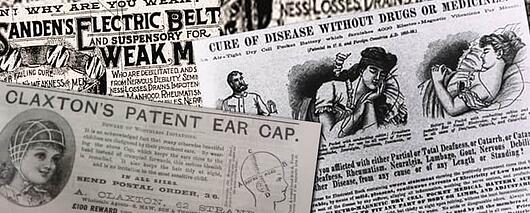Editor's Note: This post was originally published in February 2015 and has been updated for freshness, accuracy and comprehensiveness.


As a general consumer, one most likely has little need to know the difference between a treated article claim and a public health claim. However, as a consumer for products for healthcare communities, including those that make claims about antimicrobial, biocidal, or infection control supports, it's essential to know the difference. Here is a quick overview.

A Victorian electric belt? What could possibly go wrong?
First, a little history. Before regulation, manufacturers could make any number of health promises about their products, regardless of truth, testing, or even basic safety without consequence, leaving the consumer vulnerable to a false sense of security. There was basically a free-for-all when it came to selling products purported to improve one's health. Included in this confusing and dishonest marketplace were products that claimed to kill germs, pests, and other undesirable organisms. There was no way to know if any of them actually did what they said they did.
Enter the US government. In 1910, the Federal Insecticide Act (later, the Federal Insecticide, Fungicide, and Rodenticide Act or FIFRA) was passed to protect consumers from this rampant dishonest marketing. Administered by the Environmental Protection Agency (EPA), this law and its enforcement aims to protected the general public as well as the environment from useless or even harmful products. The EPA continues to be the government body that regulates what manufacturers can (and can't) say about their products in advertising, marketing materials, or other communications. (The Food and Drug Association regulates products that come into contact with the body such as medicines, creams, and even textiles.)
This brings us to the regulations about the way products that limit or kill germs can be marketed to the consumer.
FIFRA regulates pesticides - any product that mitigates pests ("any fungus, bacterium, virus, or other microorganism, except for those on or in living man or other living animals and those on or in processed food or processed animal feed, beverages, drugs"). To be registered with the EPA, the product must pass numerous tests and achieve specific kill rates depending on the type of organism, and many other criteria (read more in our earlier post). Passing these tests results in an EPA registration for Public Health Claims.
But what about products that are useful, don't pose a public health risk, and also play a role in mitigating pests, but only those that don't affect human health? For this area, the EPA created an exemption, which they called the Treated Article Exemption. To qualify for the treated article exemption of FIFRA, the product must contain an EPA-registered pesticide. In addition, treated article claims are restricted to making claims only about how that product itself is protected. The product, which has been "treated" with an EPA-registered chemical, is protected from microorganisms. Here are some examples of treated article claims:
- "Kills odor-causing bacteria."
- "Prevents discoloration due to mold."
- "Mildew-resistant."
Note that in each of those statements, only the product is protected, not the user. Also, these products may only slow or inhibit the growth of certain microorganisms; they are not required to kill them. Finally, the term "germ" may not be used, as the EPA has determined that germs are disease- and illness-causing microorganisms. There are numerous other guidelines, which can be found here.
However, a product whose manufacturer believes can pass the EPA's rigorous testing protocols, which require a zero-fail rate, can be tested for Public Health Claims. If achieved, the product can make claims that effect the user's health, thus, a public health claim. Here are some examples of public health claims:
- "Actively kills >99.9% of germs in under two hours."
- "Kills cold and flu viruses."
- "Kills 99.9% of common household germs."
- "Biocidal"
- "Bactericidal"
These claims make clear statements about what they kill, with actual numbers, and can use the word "germs". These are statements that have been allowed by the EPA after rigorous testing demonstrating that these claims are, in fact, true.
Are you ready to take a little quiz? Check out this site's explanation of the treated article exemption, which includes a fun game to test your understanding.
So what does this mean to you as a consumer? Well, for one thing, you won't see advertisements about these items in the same way again! Now you will know what goes on behind each claim that is made, and are equipped to make better decisions about the products you bring into your home or workplace. There is clearly a need for treated articles alongside products that make public health claims, but the more you know about their distinction, the better you will be able to weigh your choices.


![[infographic] Understanding EPA Public Health Claims Download and share!](https://no-cache.hubspot.com/cta/default/216314/interactive-178732435278.png)


